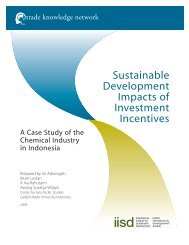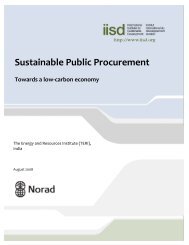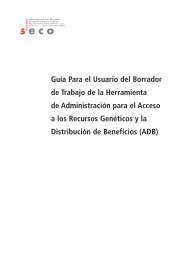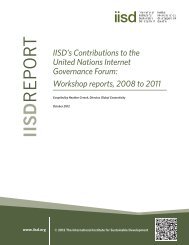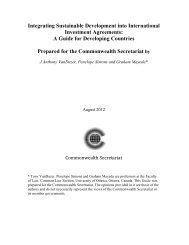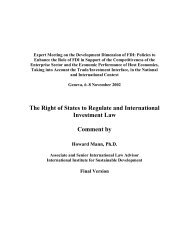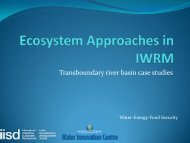Earthenterprise Tool Kit - International Institute for Sustainable ...
Earthenterprise Tool Kit - International Institute for Sustainable ...
Earthenterprise Tool Kit - International Institute for Sustainable ...
You also want an ePaper? Increase the reach of your titles
YUMPU automatically turns print PDFs into web optimized ePapers that Google loves.
EarthEnterprise <strong>Tool</strong> <strong>Kit</strong><br />
TOOL<br />
• Alternative products whose use and disposal prevents or reduces pollution.<br />
These include phosphate-fre e , b i o d e g radable deterg e n t s , l e a d - f re e<br />
gasoline, mercury-free batteries, water-based paints and adhesives, and<br />
non-toxic cleansers.<br />
Pollution prevention is being driven by environmental regulation (particularly<br />
the new focus on per<strong>for</strong>mance rather than prescription), and by the pressures<br />
of economics, consumer awareness, and the need to modernize industry.<br />
Industrial pollution is often caused by outdated and inefficient technologies<br />
that are material and energy intensive and produce unwanted by-products.<br />
Improving and replacing these technologies with more eco-efficient processes<br />
generally reduces input costs, streamlines production, eliminates or reduces<br />
waste streams, and saves money, at least over the long-term.<br />
On the consumer side, green products help fulfill the growing demand <strong>for</strong> an<br />
environmentally friendly lifestyle. When first introduced, green products are<br />
frequently priced somewhat higher than their conventional equivalents, but<br />
market acceptance and economies of scale often eliminate the price differential.<br />
Rising waste disposal costs, especially <strong>for</strong> hazardous substances, and proposed<br />
fiscal re<strong>for</strong>ms, to favour environmentally superior products and tax unwanted<br />
pollutants, will increase the economic appeal of green products.<br />
<strong>Sustainable</strong> Technologies<br />
Because of the need to achieve a combination of environmental, economic, and<br />
social objectives, the transition to sustainable technologies is becoming<br />
imperative, not just <strong>for</strong> environmental sectors, but <strong>for</strong> all businesses. The<br />
characteristics of these technologies are important enough to warrant their own<br />
tool, below.<br />
Understand <strong>Sustainable</strong> Technologies<br />
<strong>Sustainable</strong> technologies, and the products and services they provide, are good<br />
solutions because they produce a number of benefits simultaneously. They<br />
reduce the need <strong>for</strong> the environment/economy tradeoffs that characterize<br />
remediation and abatement approaches–principally by capturing the economic<br />
advantages of energy and resource efficiency.<br />
Current examples of sustainable or near-sustainable technologies and products<br />
include:<br />
• Daylight-sensitive, efficient lighting products, free of toxics and heavy<br />
metals;<br />
• Wood and wood products grown, harvested,and manufactured sustainably;<br />
• Non-bleached, recycled paper with high post-consumer fibre content;<br />
BUSINESS OPPORTUNITIES IN SUSTAINABLE TECHNOLOGY<br />
59




